介词之后的动名词
- 格式:docx
- 大小:16.20 KB
- 文档页数:2

介词后填名词还是动名词?作者:杨华新来源:《广东教育(高中)》2021年第11期在做语法填空,遇到在介词后面填词,括号内的提示词是动词时,不少学生甚至老师会感到困惑:因介词后既可接名词也可接动名词,究竟是填该动词的名词形式,还是用动名词形式?请看下面这道高考题:You may drink, smoke, be overweight and still reduce your risk of _________(die)early by running.此题到底是填death呢?还是填dying?我们知道,动名词具有名词的用法,同时也依然有动词的性质。
如,动名词可以接宾语,也可以被副词修饰。
因本题所给动词后有副词early修饰,应填die的动名词形式dying。
注意:若把原题稍作改动,将early置于空格前,即reduce your risk of early_________(die),那么,此处的early就成了形容词,形容词修饰名词,就应填die的名词形式death。
判断介词后所给动词是填其名词形式还是填动名词形式,可以根据以下几个方面来确定。
一、空格后有宾语,填动名词形式Eventually they realized the importance of ________(protect)wildlife.解析:所给动词后接有名词wildlife作宾语,要用所给动词的动名词形式,填protecting。
二、空格后有状语修饰,填动名词形式He hesitated for a while before ________(reply)politely.解析:宾格后副词politely(有礼地)修饰,填动词reply的动名词形式replying。
三、空格前有定语修饰,或有形容词性物主代词、名词所有格、冠词等限定词时,填名词形式Eventually they realized the importance of wildlife ________ (protect).解析:空格前有名词wildlife充当定语,填名词protection,表示“野生动物保护”。

动名词的用法和变化1. 动名词的定义动名词,也被称为动词的现在分词,是指以-ing结尾的动词形式。
它可以作为名词的一种形式出现,具有名词的特征,可以在句子中充当主语、宾语、介词宾语等。
2. 动名词作主语动名词可以单独作为主语出现,常用于表达一般性的行为、惯、兴趣等。
例如:- Swimming is good for your health.(游泳对健康有益。
)- Eating out is expensive.(外出就餐很贵。
)3. 动名词作宾语动名词可以作为及物动词的宾语出现,表示动作的客体。
例如:- I enjoy swimming in the ocean.(我喜欢在海洋中游泳。
)- She loves dancing all night long.(她喜欢整夜跳舞。
)4. 动名词作介词宾语动名词可以作为介词的宾语出现,通常用于介词的后面。
例如:- I'm not good at speaking in public.(我不擅长公开演讲。
)- He apologized for being late.(他为迟到而道歉。
)5. 动名词的变化形式在使用动名词时,我们需要注意一些变化规则。
- 动名词的单数形式和动词原形相同,以-ing结尾。
例如:swimming(游泳)、dancing(跳舞)。
- 动名词的复数形式一般在原形后面加上-s。
例如:swimmings (游泳活动)、dancings(跳舞活动)。
- 在某些特殊情况下,动名词的变化形式可能有不规则变化。
例如:go(去)→ going(去的行为)。
6. 动名词的注意事项使用动名词时,需要注意以下几点:- 动名词作为主语时,需注意与动词原形的区别。
动名词表示的是一种普遍或抽象的概念,而动词原形则具体指向某个特定的动作。
- 动名词和不定式的区别。
不定式可以有自己的主语,而动名词本身没有主语,常通过句子的主语来表示动作的执行者。
- 动名词作为宾语时,需要注意及物动词与不及物动词的区别。
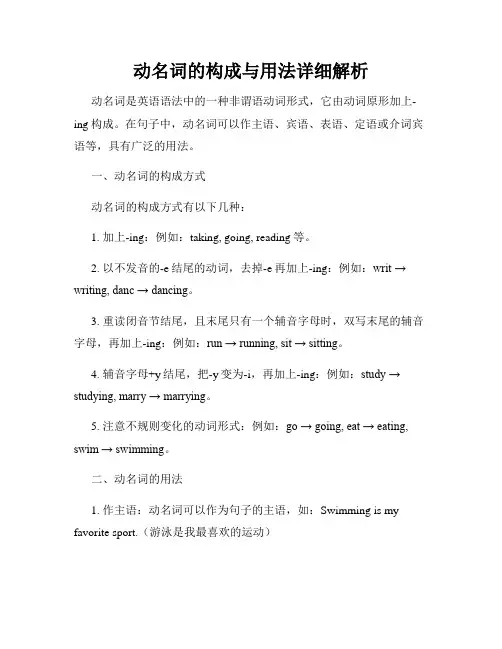
动名词的构成与用法详细解析动名词是英语语法中的一种非谓语动词形式,它由动词原形加上-ing构成。
在句子中,动名词可以作主语、宾语、表语、定语或介词宾语等,具有广泛的用法。
一、动名词的构成方式动名词的构成方式有以下几种:1. 加上-ing:例如:taking, going, reading等。
2. 以不发音的-e结尾的动词,去掉-e再加上-ing:例如:writ → writing, danc → dancing。
3. 重读闭音节结尾,且末尾只有一个辅音字母时,双写末尾的辅音字母,再加上-ing:例如:run → running, sit → sitting。
4. 辅音字母+y结尾,把-y变为-i,再加上-ing:例如:study → studying, marry → marrying。
5. 注意不规则变化的动词形式:例如:go → going, eat → eating, swim → swimming。
二、动名词的用法1. 作主语:动名词可以作为句子的主语,如:Swimming is my favorite sport.(游泳是我最喜欢的运动)2. 作宾语:动名词可以作为动词的宾语,如:I enjoy reading books.(我喜欢读书)3. 作表语:动名词可以作为系动词的表语,如:Her favorite hobby is dancing.(她最喜欢的爱好是跳舞)4. 作定语:动名词可以作为名词的定语,如:I saw a running boy.(我看到一个跑步的男孩)5. 作介词宾语:动名词可以作为介词的宾语,如:He's interested in learning English.(他对学习英语很感兴趣)6. 与情态动词连用:动名词可以与情态动词连用,表示推测、意图或能力,如:He must be sleeping.(他一定在睡觉)7. 在某些固定短语中使用:动名词在一些固定短语中使用,如:look forward to, be worth, give up等。
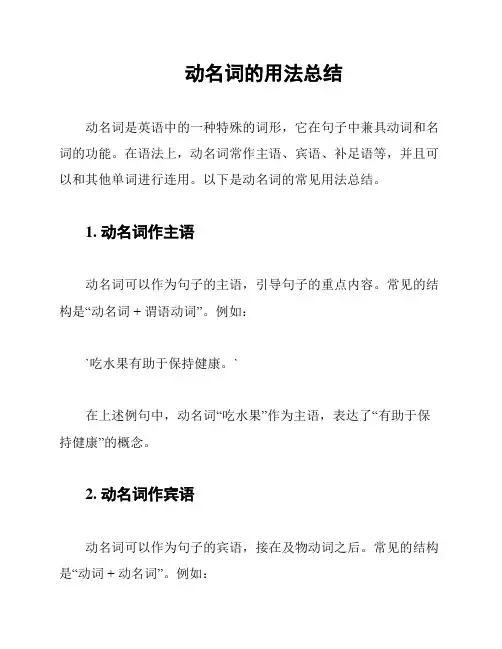
动名词的用法总结动名词是英语中的一种特殊的词形,它在句子中兼具动词和名词的功能。
在语法上,动名词常作主语、宾语、补足语等,并且可以和其他单词进行连用。
以下是动名词的常见用法总结。
1. 动名词作主语动名词可以作为句子的主语,引导句子的重点内容。
常见的结构是“动名词 + 谓语动词”。
例如:`吃水果有助于保持健康。
`在上述例句中,动名词“吃水果”作为主语,表达了“有助于保持健康”的概念。
2. 动名词作宾语动名词可以作为句子的宾语,接在及物动词之后。
常见的结构是“动词 + 动名词”。
例如:`我喜欢读书。
`在上述例句中,“喜欢”是及物动词,后面跟着动名词“读书”,表示喜欢进行读书这一行为。
3. 动名词作补足语动名词可以作为某些动词的补足语,用来补充说明主语的情况或感受。
常见的动词包括“feel”(感觉)、“find”(发现)、“keep”(保持)等。
例如:`我发现研究是一种持续的过程。
`在上述例句中,“发现”是动词,后面跟着动名词“研究”,表示主语发现了研究是一种持续的过程。
4. 动名词作定语动名词可以作为名词的定语,用来修饰名词。
常见的结构是“动名词 + 名词”。
例如:`跑步锻炼对身体健康很好。
`在上述例句中,“锻炼”是动名词,修饰名词“跑步”,表示通过跑步来进行锻炼对身体健康很好。
5. 动名词作介词宾语动名词可以作为介词的宾语,跟在介词之后。
常见的结构是“介词 + 动名词”。
例如:`我对于旅行有着浓厚的兴趣。
`在上述例句中,“对于”是介词,后面跟着动名词“旅行”,表示主语对旅行有浓厚的兴趣。
6. 动名词作目的状语动名词可以作为句子的状语,表示动作的目的或原因。
常见的结构是“动名词 + 动词”。
例如:`我去图书馆借书研究。
`在上述例句中,“借书研究”是动名词作为目的状语,说明主语去图书馆的目的是为了借书研究。
综上所述,动名词在句子中有多种不同的用法,包括作主语、宾语、补足语、定语、介词宾语和目的状语等。
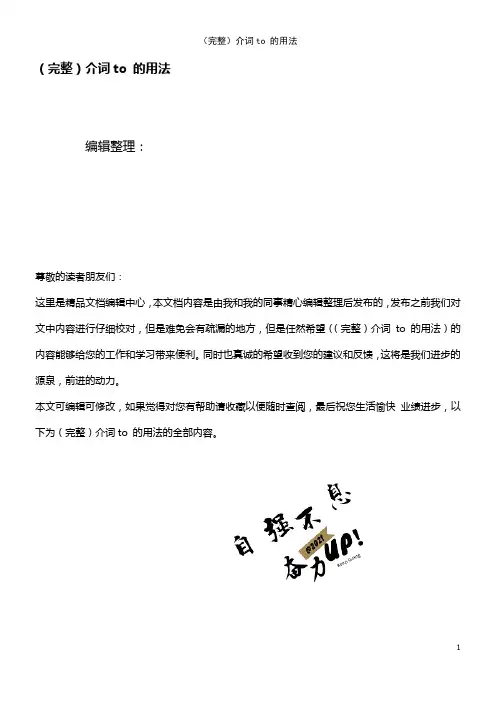
(完整)介词to 的用法编辑整理:尊敬的读者朋友们:这里是精品文档编辑中心,本文档内容是由我和我的同事精心编辑整理后发布的,发布之前我们对文中内容进行仔细校对,但是难免会有疏漏的地方,但是任然希望((完整)介词to 的用法)的内容能够给您的工作和学习带来便利。
同时也真诚的希望收到您的建议和反馈,这将是我们进步的源泉,前进的动力。
本文可编辑可修改,如果觉得对您有帮助请收藏以便随时查阅,最后祝您生活愉快业绩进步,以下为(完整)介词to 的用法的全部内容。
介词to后+动名词一览表由于to既可用作介词,也可用作不定式符号,所以其后接动词时,使用动词原形还是动名词不好判断;现对这类结构作以归纳,总结出介词to后接动名词的常考结构27个,并根据其特点,分为以下四类:一. 动词+介词to+动名词结构1。
admit to doing 承认做某事 2. apply to doing适用于做某事3. object to doing 反对做某事4. see to doing 负责做某事5。
stick to doing 坚持做某6。
take to doing 喜欢上做某事,逐渐习惯做某事7.lead to 通向8. devote oneself to doing专心致力于做某事,献身做某事eg. he admitted to having stolen the money.他承认投了钱these methods apply to learning english。
这些方法适用于he objected to being treated like a child。
他反对被当作小孩子看待reporters should stick to investigating the facts. 记者应坚持调查事实.soon he took to sleeping late. 不久他就养成了睡懒觉的习惯二。
动词+宾语+介词to+动名词作宾语结构9。

介词后面跟动名词的例子
介词后面通常跟名词或动名词,以下是介词后面跟动名词的一些例子
1.在晚上(in the evening): 在这个短语中,介词“在”后面跟了动名词“晚上
2.对于旅行(for travelling): 在这个短语中,介词“对于”后面跟了动名词“旅行"
3.关于这个话题(about this topic): 在这个短语中,介词“关于”后面跟了动名词“这个话题”
4.除了上班(except for working):在这个短语中,介词“除了”后面跟了动名词“上班”
5.而不是学习(instead of studying):在这个短语中,介词“而不是”后面跟了动名词“学习”
这些例子表明,介词后面可以跟动名词,以表达特定的意思或概念.。
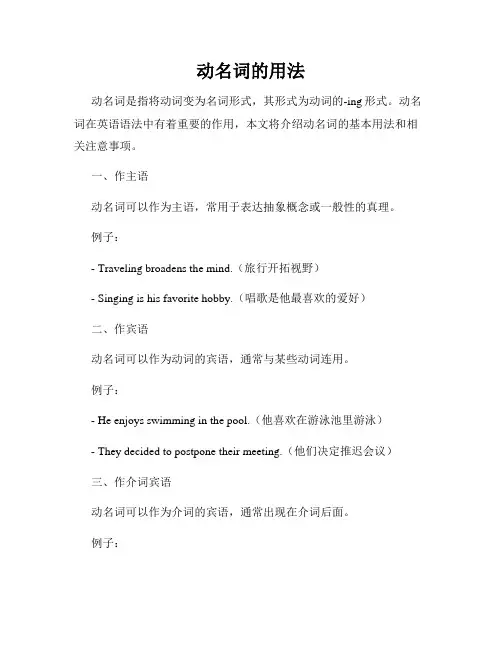
动名词的用法动名词是指将动词变为名词形式,其形式为动词的-ing形式。
动名词在英语语法中有着重要的作用,本文将介绍动名词的基本用法和相关注意事项。
一、作主语动名词可以作为主语,常用于表达抽象概念或一般性的真理。
例子:- Traveling broadens the mind.(旅行开拓视野)- Singing is his favorite hobby.(唱歌是他最喜欢的爱好)二、作宾语动名词可以作为动词的宾语,通常与某些动词连用。
例子:- He enjoys swimming in the pool.(他喜欢在游泳池里游泳)- They decided to postpone their meeting.(他们决定推迟会议)三、作介词宾语动名词可以作为介词的宾语,通常出现在介词后面。
例子:- Are you interested in learning a new language?(你对学习一门新语言感兴趣吗?)- She is good at playing the piano.(她擅长弹钢琴)四、作定语动名词可以作为名词的修饰语,用来表示被修饰名词的用途、目的等。
例子:- The writing room is for staff only.(写作室仅对员工开放)- I bought an exercise book for practicing writing.(我买了一本练习写作的练习册)五、作宾语补足语动名词可以作为某些及物动词的宾语补足语,用来补充说明宾语的具体内容。
例子:- I find it fascinating talking to people from different cultures.(我觉得和来自不同文化背景的人交谈很有趣)- He considers playing football a waste of time.(他认为踢足球是浪费时间)六、作动词不定式的替代在某些情况下,动名词可以替代动词不定式。
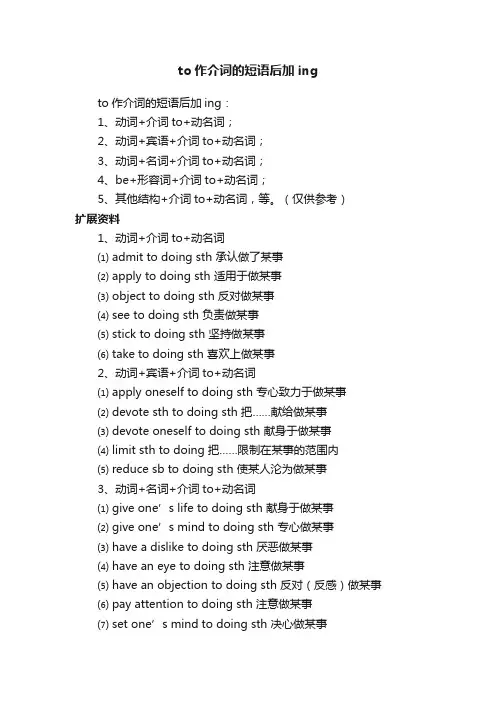
to作介词的短语后加ingto作介词的短语后加ing:1、动词+介词to+动名词;2、动词+宾语+介词to+动名词;3、动词+名词+介词to+动名词;4、be+形容词+介词to+动名词;5、其他结构+介词to+动名词,等。
(仅供参考)扩展资料1、动词+介词to+动名词⑴ admit to doing sth 承认做了某事⑵ apply to doing sth 适用于做某事⑶ object to doing sth 反对做某事⑷ see to doing sth 负责做某事⑸ stick to doing sth 坚持做某事⑹ take to doing sth 喜欢上做某事2、动词+宾语+介词to+动名词⑴ apply oneself to doing sth 专心致力于做某事⑵ devote sth to doing sth 把……献给做某事⑶ devote oneself to doing sth 献身于做某事⑷ limit sth to doing 把……限制在某事的范围内⑸ reduce sb to doing sth 使某人沦为做某事3、动词+名词+介词to+动名词⑴ give one’s life to doing sth 献身于做某事⑵ give one’s mind to doing sth 专心做某事⑶ have a dislike to doing sth 厌恶做某事⑷ have an eye to doing sth 注意做某事⑸ have an objection to doing sth 反对(反感)做某事⑹ pay attention to doing sth 注意做某事⑺ set one’s mind to doing sth 决心做某事4、be+形容词+介词to+动名词⑴ be equal to doing sth 等于做某事,能胜任做某事⑵ be used to doing sth 习惯于做某事⑶ be opposed to doing sth 反对做某事⑷ be reduced to doing sth 使某人沦为做某事⑸ be devot ed to doing sth 把时间(钱、精力等)献给做某事⑹ be limited to doing sth 把……限制在做某事的范围内5、其他结构+介词to+动名词⑴ get down to doing sth 开始做某事,认真处理某事⑵ look forward to doing sth 盼望做某事⑶ what do you say to doing sth 你认为做某事如何?。
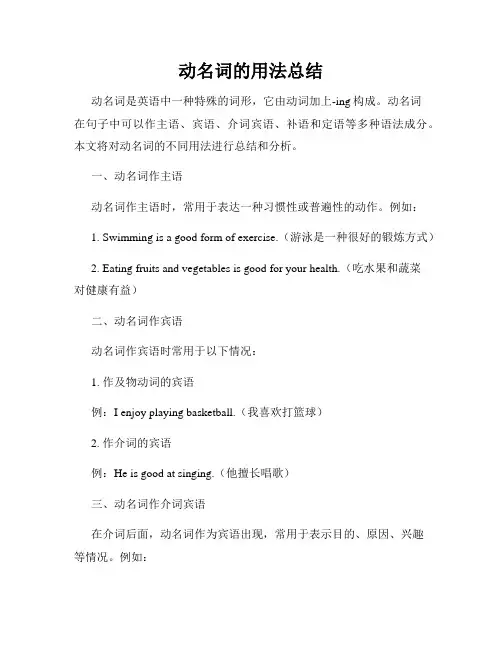
动名词的用法总结动名词是英语中一种特殊的词形,它由动词加上-ing构成。
动名词在句子中可以作主语、宾语、介词宾语、补语和定语等多种语法成分。
本文将对动名词的不同用法进行总结和分析。
一、动名词作主语动名词作主语时,常用于表达一种习惯性或普遍性的动作。
例如:1. Swimming is a good form of exercise.(游泳是一种很好的锻炼方式)2. Eating fruits and vegetables is good for your health.(吃水果和蔬菜对健康有益)二、动名词作宾语动名词作宾语时常用于以下情况:1. 作及物动词的宾语例:I enjoy playing basketball.(我喜欢打篮球)2. 作介词的宾语例:He is good at singing.(他擅长唱歌)三、动名词作介词宾语在介词后面,动名词作为宾语出现,常用于表示目的、原因、兴趣等情况。
例如:1. I went to the park for walking my dog.(我去公园遛狗)2. She apologized to her friend for making a mistake.(她对她的朋友道了歉,因为犯了一个错误)四、动名词作补语动名词可以作某些动词的补语,这些动词包括keep, catch, find, imagine等。
例如:1. I caught him stealing my money.(我抓到他偷我的钱)2. He found his cat sleeping on the sofa.(他发现他的猫在沙发上睡觉)五、动名词作定语动名词可以作修饰名词的定语,常出现在名词前面。
例如:1. The running water is so clear.(流动的水非常清澈)2. I saw a dancing girl on the stage.(我在舞台上看到了一个跳舞的女孩)总结:动名词可以作主语、宾语、介词宾语、补语和定语等多种语法成分。
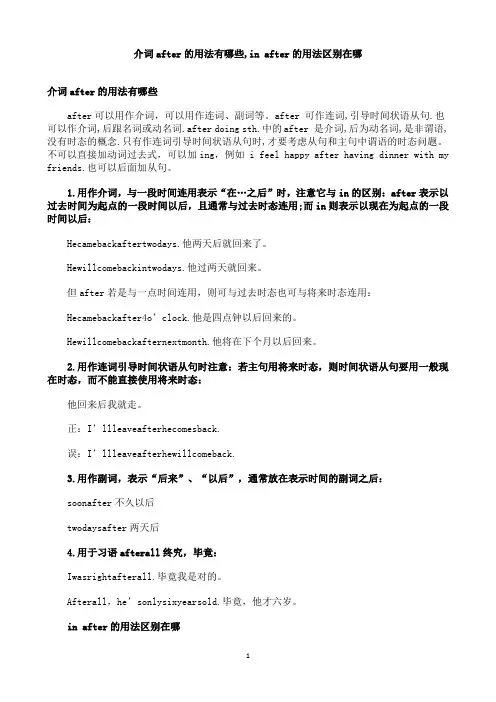
介词after的用法有哪些,in after的用法区别在哪介词after的用法有哪些after可以用作介词,可以用作连词、副词等。
after 可作连词,引导时间状语从句.也可以作介词,后跟名词或动名词.after doing sth.中的after 是介词,后为动名词,是非谓语,没有时态的概念.只有作连词引导时间状语从句时,才要考虑从句和主句中谓语的时态问题。
不可以直接加动词过去式,可以加ing,例如 i feel happy after having dinner with my friends.也可以后面加从句。
1.用作介词,与一段时间连用表示“在…之后”时,注意它与in的区别:after表示以过去时间为起点的一段时间以后,且通常与过去时态连用;而in则表示以现在为起点的一段时间以后:Hecamebackaftertwodays.他两天后就回来了。
Hewillcomebackintwodays.他过两天就回来。
但after若是与一点时间连用,则可与过去时态也可与将来时态连用:Hecamebackafter4o’clock.他是四点钟以后回来的。
Hewillcomebackafternextmonth.他将在下个月以后回来。
2.用作连词引导时间状语从句时注意:若主句用将来时态,则时间状语从句要用一般现在时态,而不能直接使用将来时态:他回来后我就走。
正:I’llleaveafterhecomesback.误:I’llleaveafterhewillcomeback.3.用作副词,表示“后来”、“以后”,通常放在表示时间的副词之后:soonafter不久以后twodaysafter两天后4.用于习语afterall终究,毕竟:Iwasrightafterall.毕竟我是对的。
Afterall,he’sonlysixyearsold.毕竟,他才六岁。
in after的用法区别在哪▲in 与after 均可表示“在……之后”,与一段时间连用时,after表示以过去时间为起点的一段时间以后,因此通常与过去时连用。

介词的用法归纳介词后面跟什么英语中介词后面必须跟名词、代替名词的代词、和名次共一样的动名词(-ing),以及名词短语、名词性从句---宾语从句。
这就是介词的主要用法。
1 介词的基本用法英语中介词后面必须跟名词、代替名词的代词、和名次共一样的动名词(-ing),以及名词短语、名词性从句---宾语从句。
这就是介词的主要用法。
1.后跟名词例如:at school 在上学,in person 亲自,on duty 值班,at work在上班,by hand 用手,with pleasure 乐意等。
2.后跟代词:I’m on it. 我来办。
stand by him 站在他身边few of them 他们中的少数几个part of it 其中一部分depend on you 指望你3.后跟动名词:do well in dancing 擅长跳舞be good at swimming 擅长游泳how about going traveling 去旅行怎幺样be fond of cycling 酷爱骑行1 英语介词怎幺用⑴时间或地点介词in、on、at 的用法区别:表示时间时, in 表示在一段时间里(在将来时句子中则表示在一段时间之后), on 表示在具体的某一天或者某天的上下午等, at 表示在某个时刻或者瞬间;表示地点时, in 表示在某个范围之内, on 表示在某个平面上或与一个面相接触,at 则表示在某个具体的场所或地点.如:He was born on the morning of May 10th.(他出生于五月十日的早晨)/ I usually get up at 7:00 in the morning.(我通常在早上的七点钟起床) / His glasses are right on his nose.(他的眼镜就架在他的鼻子上)/ He is atthe cinema at the moment.(此刻他正在电影院)⑵after 与in 表示时间的用法区别:“after+(具体时刻/从句)”表示“在…时刻。
介词后面可以跟名词或代词,若要跟动词需用现在分词。
英语中,介词后面经常跟名词或名词词组、代词、动名词或句子。
有时名词会有修饰词,但整体上仍然是名词或名词词组;不可以跟形容词,副词等。
英语中介词后面跟什么
英语中,介词后面经常跟名词或名词词组、代词、动名词或句子。
有时名词会有修饰词,但整体上仍然是名词或名词词组;不可以跟形容词,副词等。
例如:
We look for a proper(形容词,修饰后面名词) person for the job.名词短语。
I am looking forward toreceiving your early reply动名词短语
英语介词介绍
介词,又称作前置词,表示名词、代词等与句中其它词的关系,在句中不能单独作句子成分。
介词后面一般有名词、代词或相当于名词的其他词类、短语或从句作它的宾语,表示与其他成分的关系。
介词和它的宾语构成介词词组,在句中作状语,表语,补语,定语或介词宾语。
同时介词的用法也很灵活,同一个介词可以表达多种意义,介词可以分为时间介词、地点介词、方式介词、原因介词、数量介词和其他介词。
介词一般用于名词或者代词前面,表示该词与句中其他成分的关系。
介词后面的名词或代词称为介词宾语(如果是人称代词,则要用宾格)。
介词和介词宾语合在一起构成介词短语。
初中英语介词知识点:五种介词短语
各位读友大家好,此文档由网络收集而来,欢迎您下载,谢谢
初中英语介词知识点:五种介词短语
英语介词不可单独使用,只能与不同的此类构成介词短语来在句子中担当一个成分。
常用的五种介词短语
1.介词+名词:at the door, into the bag
2.介词+代词: for me, of others
3.介词+动名词: in doing so, to my saying that
4.介词+连接副词/连接代词/what从句:over what he had better do
5.介词+连接副词/连接代词+不定式:on how to do this
其他类型的介词短语
6.介词+介词短语:from across the
street, until after dinner
7.介词+副词:from below
8.介词+复合结构:with the light on
9.介词+不定式:…did nothing but sleep介词-- 连接词与词纽带
英语经常用介词来表示词与词之间的关系
相关推荐:初中英语介词知识点:时间介词
点击查看更多信息
各位读友大家好,此文档由网络收集而来,欢迎您下载,谢谢。
介词to后+动名词结构一览用法归纳由于to既可用作介词,也可用作不定式符号,所以许多学生在其后接动词时,弄不清到底该用动词原形,还是用动名词。
本文根据新课标词汇(比考试大纲词汇范围稍广)对这类结构作了一次系统归纳,总结出介词to后接动名词的常考结构27个,并根据其结构特点,分为以下四类:一、动词+介词to+动名词作宾语结构。
这一种结构是考试中的大热考点,考生容易产生定势思维,想当然的认为“to”之后要跟"to do"不定式,所以,请特别重视下列含有“to"的动词短语。
1. admit to doing sth 承认做了某事2. apply to doing sth 适用于做某事3. object to doing sth 反对做某事4. see to doing sth 负责做某事5. stick to doing sth 坚持做某事6. take to doing sth 喜欢上做某事,逐渐习惯做某事。
7. lead to通向8. see to 负责应用实例:1.He admitted having stolen the money. 他承认偷了钱。
2.These methods apply to learning English.这些方法适用于英语学习。
3.He objected to being treated like a child. 他反对被当作小孩子看待。
4.Reporters should stick to investigating the facts. 记者应坚持调查事实。
5.Soon he took to sleeping late. 不久他就养成了睡懒觉的习惯。
二、动词+宾语+介词to+动名词作宾语结构9. devote oneself to doing sth专心致力于做某事把……献给做某事;献身于做某事10. limit sth to doing sth 把…限制在做某事的范围内11. reduce sb to doing sth 使某人沦为做某事12. give one’s life to doing sth 献身于做某事13. give one’s mind to doing sth 专心做某事14. have a dislike to doing sth 厌恶做某事15. have an eye to doing sth 非常注意做某事,着眼于16. have an objection to doing sth 反对(反感)做某事17. pay attention to doing sth 注意做某事18. set one’s mind to doing sth 决心做某事应用实例:1.She applied herself to learning English. 她专心学习英语。
介词后+动名词结构一览用法归纳由于to既可用作介词,也可用作不定式符号,所以许多学生在其后接动词时,弄不清到底该用动词原形,还是用动名词。
本文根据新课标词汇(比考试大纲词汇范围稍广)对这类结构作了一次系统归纳,总结出介词to后接动名词的常考结构27个,并根据其结构特点,分为以下四类:一、动词+介词to+动名词。
这一种结构是考试中的大热考点,考生容易产生定势思维,想当然的认为“to”之后要跟"to do"不定式,所以,请特别重视下列含有“to"的动词短语。
1. admit to doing sth 承认做了某事2. apply to doing sth 适用于做某事3. object to doing sth 反对做某事4. see to doing sth 负责做某事5. stick to doing sth 坚持做某事6. take to doing sth 喜欢上做某事,逐渐习惯做某事。
7. lead to通向8. see to 负责应用实例:He admitted having stolen the money. 他承认偷了钱。
These methods apply to learning English.这些方法适用于英语学习。
He objected to being treated like a child. 他反对被当作小孩子看待。
Reporters should stick to investigating the facts. 记者应坚持调查事实。
Soon he took to sleeping late. 不久他就养成了睡懒觉的习惯。
二、动词+宾语+介词to+动名词9.devote oneself to doing sth专心致力于做某事把……献给做某事;献身于做某事10. limit sth to doing sth 把…限制在做某事的范围内11. reduce sb to doing sth 使某人沦为做某事12. give one’s life to doing sth 献身于做某事13. give one’s mind to doing sth 专心做某事14. have a dislike to doing sth 厌恶做某事15. have an eye to doing sth 注意做某事15. have an eye to doing sth16. have an objection to doing sth 反对(反感)做某事17. pay attention to doing sth 注意做某事18. set one’s mind to doing sth 决心做某事应用实例:She applied herself to learning English. 她专心学习英语。
介词短语的构成形式1、介词+名词:Unfortunately,there wasn't enough demand for our product.不幸的是,我们的产品市场需求不大。
2、介词+代词:He always carried the photo with him.他总是随身带着那张相片。
3、介词+动名词:He entered the room without taking off his shoes.他没有脱掉鞋就进了房间。
4、介词+数词:She is a mother of two.她是一位有两个儿子的母亲。
5、介词+ 形容词或副词:I heard someone calling me from below.我听见有人在下面叫我。
6、介词+另一个介词+名词:We never play bridge until after dinner.我们只在晚饭后打桥牌。
7、介词+名词性从句:The exercise are well done expect that some words are misspelled. 除了有些拼写错误之外,这些练习做得不错。
The car stopped only a few inches from where I stood. 汽车在离我站的地方仅几英寸处停下来了。
8、介词+复合结构:I had no objection to Jenny marrying him.我不反对詹妮和他结婚。
9、介词+动词不定式:I had no alternative but to walk out.我别无他法只好走出去。
动名词的用法动名词(Gerund)是英语中一种特殊的动词形式,它以-ing结尾,并且在句中起名词的作用。
动名词可以作为主语、宾语、介词宾语和表语等,具有多种用法。
本文将详细介绍动名词的用法及相应的例句。
一、作为主语动名词可以作为句子的主语,在句子中起到了名词的作用。
以下是一些常见的用法示例:1.Playing basketball is my favorite sport.–打篮球是我最喜欢的运动。
2.Learning languages requires time and patience.–学习语言需要时间和耐心。
3.Swimming is good for your health.–游泳对身体健康有益。
二、作为宾语动名词可以作为及物动词的宾语,跟在动词后面。
以下是一些常见的用法示例:1.I enjoy reading books in my free time.–我空闲时喜欢读书。
2.They avoid eating junk food.–他们避免吃垃圾食品。
3.She prefers watching movies to going shopping.–她喜欢看电影而不是逛街。
三、作为介词宾语动名词可以作为介词的宾语,放在介词后面。
以下是一些常见的用法示例:1.He is good at playing the piano.–他擅长弹钢琴。
2.We are interested in learning new things.–我们对学习新事物感兴趣。
3.She is afraid of flying in airplanes.–她害怕坐飞机。
四、作为表语动名词可以作为系动词的表语,说明主语的身份或特征。
以下是一些常见的用法示例:1.Her favorite activity is painting.–她最喜欢的活动是绘画。
2.The best thing for you is relaxing.–对你来说最好的事情是放松。
介词之后的动名词
1.如把动词直接放在介词后面,就必须用动名词的形式:
What can you do besides typing?
除了打字你还会做什么?
I have no objection to hearing your story again.
再听一遍你的故事,我没有异议。
Touch your toes without bending your knees.
试着不屈膝去够你的脚趾。
He is good at diving.
他擅长跳水。
She is fond of climbing.
她喜欢爬山。
I’m not keen on gambling. I’m too afraid of losing.
我对赌博不感兴趣。
我太怕输了。
He was fined for being drunk in charge of a car.
他因酒醉驾车被罚款。
I’m against saying anything./I’m for saying nothing.
我反对说话。
/我赞成什么都不说。
I’m tired of arguing. I’m fed up waiting.
我厌烦争辩了。
我等得腻味极了。
(口语)
This is a tool for opening tins.
这是一个开罐头的工具。
Do you feel like going out?
你想出去玩吗?
After swimming I felt cold.
游完泳我感到冷。
2.某些动词+介词/副词(即短语动词)后面要求接动名词。
最常用的这
类组合有be for/against, care for, give up, keep on, leave off, look forward to, put off, see about, take to.
I don’t care for standing in queues.
我不喜欢排队。
Eventually the dogs left off barking.
狗终于不叫了。
I am looking forward to meeting her.
我渴望见到她。
He put off making a decision till he had more information.
他推迟到获得详情之后再决定。
He took to ringing us u in the middle of the night.
他开始习惯在半夜给我们打电话。